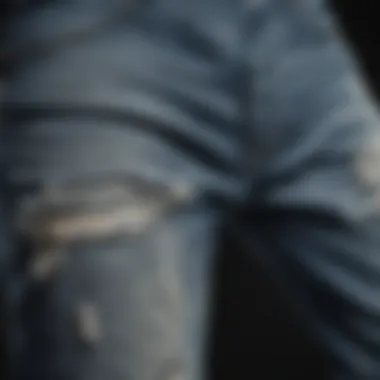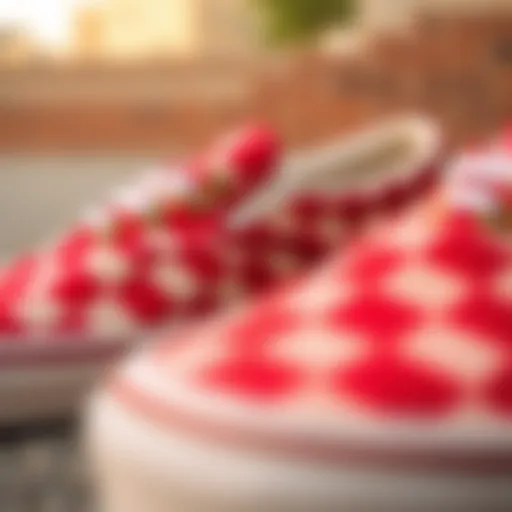Ripped Men's Jeans: A Key Element in Skate Culture


Intro
Ripped men’s jeans occupy a unique space in the world of skate culture. They reflect a blend of practicality, rebellion, and style that resonates with skaters everywhere. This article sheds light on their evolution, detailing how these once-simple garments became a crucial part of skater identity.
The journey of denim in this subculture intertwines with the history of skateboarding itself. By examining this relationship, we can appreciate not only fashion but also the culture and lifestyle surrounding it. Let’s dive into the techniques and skills relevant to skaters, as well as their powerful cultural roots.
Prelims to Ripped Men's Jeans
In the world of skateboarding, ripped men's jeans have carved a unique niche that transcends mere fashion. As skate culture blossomed, so did the embodiment of individualism expressed through clothing. This section seeks to shine a light on why ripped jeans matter, not just as a clothing choice, but as a cultural marker that resonates deeply with skaters and enthusiasts alike.
Defining Ripped Jeans
Ripped jeans can be defined as denim fabric that purposely features tears or frays, giving them a distressed look. This aesthetic symbolizes a defiance against conventionality—the very ethos of skate culture. As practical as they are symbolic, these jeans have transformed from being merely a statement of rebellion to a staple in the wardrobes of skaters.
The appeal lies in their informal nature; the tears and abrasions suggest that the wearer is not afraid to “grind it out” on the skate park or city streets. Different styles are notable, from subtle frays at the knees to pronounced rips along the thighs. This diversity allows for personal expression, as skaters can choose how much or how little wear to showcase.
Cultural Significance
Ripped jeans serve as more than just a fashion choice; they encapsulate a lifestyle and community. The roots of this cultural significance trace back to the punk movement and the spiraling aesthetics of rebellion in the late 20th century. Skaters adopted this style as a way to distance themselves from the mainstream narrative. Wearing ripped jeans is akin to wearing a badge of honor, signaling to others that one is part of a nonconformist tribe.
The cultural fabric of skateboarding is tightly woven with notions of risk and freedom—both on the board and in self-expression. These garments not only reflect skaters' attitudes but are also often adorned with elements like patches or paint, further personalizing the look. The look permeates community gatherings, social media, and events, creating a visual conversation around identity in skate culture.
"Fashion is what you’re offered four times a year by designers. And style is what you choose." - Lauren Hutton
From streetwear to skate fashion, the journey of ripped jeans symbolizes a communal evolution, where style acts as a canvas for expressing values that resonate across generations. Ripped jeans are less about fitting in and more about standing out, embodying the spirit of those who dare to carve their path in concrete jungles.
Whether it’s cruising down streets or catching air at the local park, ripped men's jeans represent not just a piece of clothing, but an identity that many skaters proudly embrace.
Historical Context
Understanding the historical context of ripped men's jeans within skate culture provides a foundation for appreciating their significance today. This section delves into the origins and transformations of denim, illustrating how it shifted from purely practical use to becoming a staple in fashion, particularly in alternative cultures like skateboarding.
The Origins of Denim
Denim’s journey dates back to the late 19th century, originating in Nîmes, France, where we first find the term "serge de Nîmes," which eventually morphed into the word denim. The material was originally woven from durable cotton and designed for workers who needed tough gear that could withstand the rigors of labor. Jean trousers made an appearance as early as the 1870s, invented by Levi Strauss and Jacob Davis, who recognized the need for reliable workwear for miners amid the Gold Rush craze in California.
Over the years, denim's adaptability caught the attention of the masses. It became the fabric of choice for various subcultures, functioning as a canvas for self-expression. The pivotal point occurred during the mid-20th century, as denim started to seep into the popular cultural landscape, thanks to icons like Marlon Brando and James Dean. They were often seen donning denim jackets and jeans, shifting public perception. Denim wasn’t just for work anymore; it stood for rebellion and freedom—a message that resonated with youth.
"Denim was more than fabric; it was a lifestyle. It was about standing out and breaking away from societal norms."
From Workwear to Fashion Statement
As society progressed through the latter half of the 20th century, denim began shedding its blue-collar roots, reemerging as a high-profile fashion statement. The 1980s marked a significant turning point, with ripped and distressed jeans making waves as a symbol of counterculture and nonconformity. This was especially evident in music and film, where punk and grunge scenes celebrated the raw, unrefined look of ragged denim.


In the skateboarding community, this trend mirrored the skater's relationship with freedom and individuality. Skaters gravitated toward ripped jeans not only for comfort but also as an outward expression of their identity. The frayed edges and worn patches told a story of adventure, of the spills and thrills that came with skateboarding culture.
Several elements contributed to this transformation:
- Cultural Rebellion: Ripped jeans became a badge of defiance against the polished fashion of the mainstream.
- Practical Use: For skaters, the rips enhanced mobility, making it easier to perform tricks without feeling constricted.
- Self-Expression: Customization became key; decorating jeans with patches or additional rips personalized the style.
Thus, as we look at the evolution of ripped jeans, it's crucial to note that their transition from a utilitarian item to a pinnacle of fashion speaks volumes of societal values, particularly regarding youth culture and skater identity. The fabric that began as workers' necessity is now interlaced with narratives of rebellion, identity, and artistic expression.
The Rise of Ripped Jeans in Skateboarding
Ripped jeans have found a distinct place in skateboarding culture, symbolizing not just a fashion choice but a lifestyle. As skateboarding evolved from a fringe sport to a recognized global phenomenon, the styles worn by skaters mirrored their community's values—rebellion, individuality, and freedom of expression. This section dives into how ripped jeans became synonymous with skate culture, highlighting their adoption by skaters and the influential figures steering the trend.
Adoption by Skaters
Anyone who has watched skaters perform tricks on the street or at the park knows there's a certain raw authenticity in their style. Skaters picked up on ripped jeans almost instinctively, not solely for their rough-and-tumble aesthetic but also for practical reasons. The tear-and-wear aspect allowed the jeans to evolve quickly into a preferred clothing item due to their unpretentious nature.
In the early days, skaters would often modify their jeans, slashing them for comfort or for aesthetics that set them apart from mainstream fashion. It was a way to embrace an anti-establishment attitude, putting a twist on conventional styles. As the scene grew, brands like Vans and Element began to notice this trend and catered to it by producing jeans designed specifically for skaters, complete with additional flexibility and broader leg openings.
The adoption of ripped jeans reflects a deeper connection to skateboarding's roots; they embody the spirit of resilience—everything a skater faces on concrete or in the air translates into the fabric of their attire.
"Ripped jeans are not just about style; they’re about telling the story of a skater's journey and the bumps along the way."
Influential Skateboarders and Trends
Influential skateboarders have long been at the forefront of shaping fashion trends within the skating community. For instance, personalities like Tony Hawk and Bam Margera not only pushed boundaries in tricks but also influenced what the youth found fashionable. When these icons paired their bold tricks with distressed denim, it communicated that ripped jeans were more than just a trend; they became a badge of honor.
More recently, skaters like Nyjah Huston have taken to social media platforms, showcasing their unique takes on skate attire, notably ripped jeans. This visibility has further cemented their status as essentials in skateboarding wardrobes. Social media's role can’t be understated—it allowed images and videos of skaters to reach a wider audience, instantly putting their fashion choices front and center. Just a glance at platforms like Instagram or TikTok can reveal a plethora of skaters proudly wearing shredded denim while pulling off unbelievable tricks.
As streetwear continues to merge with high fashion, the evolution of ripped jeans showcases an interesting blend of attitudes and lifestyles. Whether in a bustling urban environment or an underground skatepark, these jeans carry a narrative of individuality. They tell a story that connects the skater with their street and, more importantly, with their community.
In summary, ripped jeans have transitioned from a personal choice to a cultural staple within skateboarding, driven by skaters' need for comfort, expression, and the influence of iconic figures within the sport. Their significance runs deeper than fabric and thread; they represent a collective ethos that binds the skateboarding community.
Practical Advantages of Ripped Jeans for Skaters
Ripped jeans have carved out a distinctive niche in the realm of skate culture. Beyond mere style, they carry specific advantages that cater to the unique demands of skateboarding. The practicality of ripped jeans allows skaters to express themselves while also ensuring functionality in their attire. This section will delve into two critical aspects: comfort and flexibility, as well as breathability and movement.
Comfort and Flexibility
When you’re shredding on your board, comfort is paramount. Ripped men's jeans often provide a level of flexibility that traditional denim lacks. The cuts and tears in the fabric allow for increased range of motion. This is essential for executing tricks that require agility and quick movements.
Skaters frequently find themselves in diverse positions, whether crouching low for a trick or landing mid-air. In this context, being restricted by tight clothing can hinder performance. Unlike stiff, unyielding jeans, a well-worn pair of ripped denim can move with the body. It’s almost as if they were made for skating.
The use of lighter materials in some ripped jeans can also improve comfort in warm weather, making them fire for long sessions at the skate park.
Breathability and Movement


Another important factor for skaters is breathability. Standard jeans can be hot and uncomfortable after a few hours of intense skating. However, the design of ripped jeans—often featuring strategically placed vents—enables better airflow. This feature is crucial during sweltering summer days when a skater’s body temperature can soar.
Moreover, the allowance in the fabric around the rips tends to make movement more natural. Skaters can push harder and soar higher without feeling snagged or impeded by their clothing.
"The best gear is gear you forget you're wearing," is a mantra often echoed in the skate community.
In summary, ripped jeans aren’t just a fashion trend; they serve a functional purpose. The comfort, flexibility, breathability, and adaptability they offer make them an integral part of a skater’s wardrobe. With so much to consider, it’s clear that these jeans aren't merely a style choice, but a practical asset for those who live the skateboarding lifestyle.
Styling Ripped Jeans for Skateboarding
When it comes to skateboarding, the style is just as vital as the technique. Ripped jeans have become a mainstay, blending functionality with personal expression. This section will delve into how to effectively style ripped jeans for skating, addressing the significance of fit, integration with skate gear, and the impact of accessories. Knowing how to combine these elements not only enhances your comfort on the board but also boosts your confidence in your style choices.
Choosing the Right Fit
The fit of the jeans can make or break the skater’s experience. Skaters often lean towards a fit that is both snug and flexible. A well-fitted jean should allow for ample movement while not being so loose that you risk snagging them while performing tricks. Here’s what to consider when selecting the right fit:
- Slim or straight cuts: These styles provide a clean look without overdoing it on bagginess. You want the jeans to sit at the waist but give enough room in the thighs to allow for bending.
- Length matters: Look for jeans that don’t drag on the ground but also aren’t so short that they expose too much ankle. Keeping it just above the shoe is generally ideal.
- Stretch fabric: Opt for jeans with a bit of spandex or elastane. This material gives that extra stretch needed while moving on a board, making a world of difference especially during flip tricks.
Choosing the right fit can significantly affect not only your performance but also how you project yourself among peers.
Combining with Skate Gear
Ripped jeans should be incorporated into an overall skate outfit that complements their unique style. The best looks often come from mixing and matching various casual clothes with a bit of personality. Here’s how to achieve an appealing combo:
- Graphic tees: Pair your jeans with vibrant tees featuring skate brands or rebellious slogans; these can add flair and authenticity to your ensemble.
- Hoodies and jackets: Layering can work wonders. A well-fitted hoodie or a bomber jacket can provide warmth on a chilly day, without compromising aesthetics.
- Footwear: Sneakers are a must. A solid pair of skate shoes can maintain comfort and grip, and can also add a splash of color or print that pops against the denim.
Accessorizing the Look
Don't underestimate the power of accessories when styling ripped jeans for skateboarding. They don’t just complement the overall vibe; they can also serve functional purposes. Consider the following:
- Beanies and caps: These can shield you from the sun, while also showcasing your individuality. The choice of headwear can make a bold statement about your style.
- Wristbands and watches: Adding gear like wristbands creates a streetwise aesthetics. Something simple can work, or go wild with flashy colors if that’s your vibe.
- Backpacks: Functionality is key in skate culture. A practical, stylish backpack can not only hold your essentials, but can also tie the look together nicely.
Incorporating these elements into your skatewear transforms the basic ripped jeans into a full expression of identity and comfort. Tailoring your style to include the right fit, thoughtful combinations, and suitable accessories ensures that you remain both fashionable and functional on and off the board.
Influence of Social Media on Fashion Trends
Social media has acted as the pulsing heart of fashion evolution, striking a profound chord especially within skate culture. The digital age has transformed the way trends emerge, spread, and are embraced, allowing skaters and enthusiasts to share their unique styles far beyond local skate parks.
Role of Skating Fads on Social Platforms
Platforms like Instagram, TikTok, and even Reddit have become breeding grounds for the latest in skating fashion, particularly ripped men's jeans. A simple snapshot of a skater performing a trick in well-worn, distressed denim can spark a tidal wave of copycat styles among followers. It’s not just about showcasing skills anymore; it’s about establishing a brand and identity that resonates with a global audience.
Images and videos circulate and create trends faster than a skateboarder can land a kickflip. Each upload is steeped in authenticity, where a quick glance at a skater's feed reveals their life, style, and community. Notable hashtags like #SkateFashion or #RippedJeans not only amplify visibility but also forge connections among users devoted to particular aesthetics. Skaters can see how ripped jeans not only fit their need for comfort and flexibility but also set them apart as part of a broader cultural movement.
Additionally, social media allows styles to blend and evolve. Influences from punk rock, streetwear, and even high fashion seep into skating culture, often highlighted in posts and stories. Perhaps someone sees a celebrity or a consistent figure in the skate community rocking a pair of perfectly shredded jeans, and like the wind under a skateboard, the idea takes off.


Emerging Influencers and Their Impact
With the rise of social media, a new breed of influencers has emerged. These individuals, often either professional skaters or passionate hobbyists, curate their feeds to showcase a combination of skating skills and personal style. They have the power to shape opinions and dictate styles, and ripped jeans fit right into this dynamic.
"The denim becomes a canvas for their identity; it tells a story of rebellion and freedom."
For instance, platforms like Instagram have made influencers like Nyjah Huston and Paul Rodriguez not only popular for their tricks but also for the way they style their outfits. Their choices have made ripped jeans synonymous with the skateboarding lifestyle. Newbies and veterans alike follow suit, trying to replicate looks they admire.
Furthermore, emerging influencers often highlight sustainability aspects of fashion—upcycling worn jeans, for example. They champion repurposing and customization, signaling an acute awareness of environmental issues. This is particularly crucial in skateboarding culture where individuality prevails, encouraging skaters to add their twist to each piece of denim they own.
The dialogue established through these platforms creates a shared experience that transcends geography. Furthermore, the endorsement of well-respected skaters wearing ripped jeans solidifies the trend, ensuring their survival and prominence in skate culture.
Sustainability and Ripped Jeans
The interaction between sustainability and ripped men's jeans has become an essential conversation within skate culture. In a world that increasingly values eco-conscious practices, understanding how denim production affects the environment is vital. It’s not just about looking good while riding a board; it’s about feeling good knowing you are making choices that aren't harming the planet. Let's break down this topic into two main areas: eco-conscious choices in denim production and the creative practices of upcycling and customization in skating.
Eco-Conscious Choices in Denim Production
When considering sustainability in denim production, several key factors come into play. Traditional denim manufacturing is known for its heavy water usage and the release of harmful chemicals. Skaters and brands alike are starting to recognize that the choices made in the production phase have lasting impacts. Here are a few eco-conscious initiatives shaping the denim world:
- Organic Denim: Made from cotton grown without synthetic pesticides, organic denim helps to reduce the chemical load on the environment. It supports healthier ecosystems and aligns with the values of many skaters who care about their surroundings.
- Waste Reduction Techniques: Techniques like laser distressing and ozone washing minimize water usage and energy consumption during the production process. Brands like Levi's have begun incorporating these methods to lessen their environmental footprint.
- Recycled Materials: Some brands are exploring ways to create denim from recycled fibers, giving new life to old clothing instead of sending it to landfills. This approach not only reduces waste but also conserves resources.
These choices represent a shift towards more sustainable practices in the denim industry, particularly vital to skaters who live and breathe a culture that often critiques consumerism.
Upcycling and Customization in the Skate Community
Skaters have long embraced the idea of individuality, and upcycling is a creative way to express that. Instead of buying new ripped jeans, many in the skate community choose to modify their existing clothing. This practice aligns with both personal expression and a rejection of fast fashion's throwaway culture. Here’s how upcycling has taken root in the skate world:
- Personal Style: Skaters often customize ripped jeans by adding patches, embroidery, or even further distressing to create a unique look. This signifies a move away from mass-produced fashion and towards a more personalized wardrobe.
- Community Workshops: Some local skate shops and organizations host workshops where skaters can learn to upcycle their garments. This not only fosters a sense of community but also teaches sustainable practices.
- Sharing and Trading: Platforms like Reddit and Facebook groups have grown into spaces where community members trade customized clothing. Instead of discarding a pair of jeans, a skater might find a new home for them within their circle.
"Upcycling gives new life to the old, transforming what was once discarded into something fresh and vibrant—that’s the spirit of skate culture."
The practices of upcycling and customization reflect a deeper understanding of sustainability. By embracing these methods, skaters can maintain their identity while contributing positively to the environment. The importance of sustainability in the context of ripped men's jeans cannot be understated; it's about forging a new path that honors both style and conscience.
The End: Ripped Jeans as a Cultural Artifact
The role of ripped men's jeans within skate culture cannot be overstated. They embody not just a clothing choice, but rather a cultural artifact that carries a multitude of meanings and histories. This article has illuminated the various aspects of ripped jeans, tracing their evolution and significance over the years. Ripped jeans, once a product of necessity and practicality, have evolved into symbols of personal expression, lifestyle, and community identity.
Summary of Key Points
- Origins in Functionality: From a practical perspective, ripped jeans serve a purpose; they allow skaters the necessary flexibility and breathability. Originally designed to withstand wear and tear, their utilitarian roots remain integral to their identity.
- Cultural Identity: Throughout this discussion, it’s clear that ripped jeans are intrinsically linked to the skateboarding community. They reflect a sense of rebellion and individuality, traits highly valued in skate culture. The act of customizing, whether through tears, fades, or patches, showcases skaters' creativity and personal style.
- Influence of Social Media: In today's digital age, social media platforms play a crucial role in fashion trends. Influencers have propelled the visibility of ripped jeans beyond skate parks, cementing their status in the broader cultural narrative. The portrayal of ripped jeans by popular figures highlights their versatility and significance.
- Sustainability Quest: With rising awareness of environmental issues, the skate community has also leaned towards sustainable fashion choices. Embracing upcycled materials or promoting ethical denim production merges a historical perspective of practicality with a modern twist on responsibility.
"Ripped jeans, far from being a simple fashion statement, serve as a canvas for creativity and rebellion within the skate community."
The Future of Ripped Denim in Skateboarding
As we look ahead, the future of ripped denim within skateboarding culture appears promising. The denim industry is slowly embracing eco-friendly practices, and skaters are likely to lead the charge in this evolution. The emphasis on sustainability will not only cater to environmental needs but will also reinvent the aesthetic associated with the ripped look. Moreover, as various fashion cycles repeat, ripped jeans might again find themselves at the forefront of urban fashion, merging with contemporary influences from streetwear.
Embracing evolving styles, skaters will continue to innovate. New ripped jeans designs may incorporate advanced technical fabrics, enhancing performance without losing that raw aesthetic. The collaborative spirit within the skateboarding community will undoubtedly give rise to new trends, ensuring that ripped jeans remain a staple in the identity of skaters.
Ultimately, the journey of ripped men’s jeans has been monumental. They have traversed from mere torn fabric to a representation of culture, creativity, and community resilience. As such, it will be crucial for future generations to appreciate both the history and significance behind this iconic garment.







